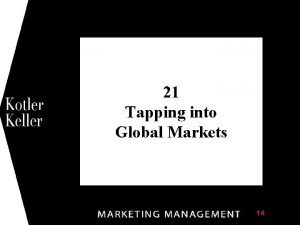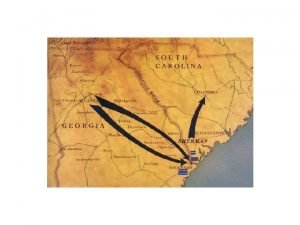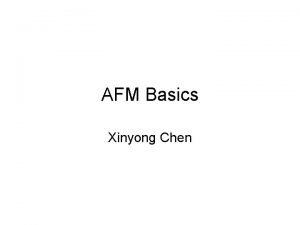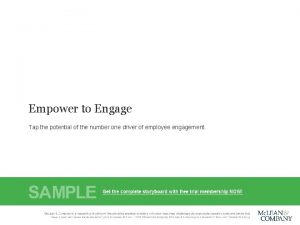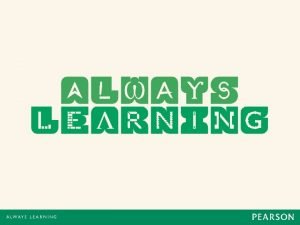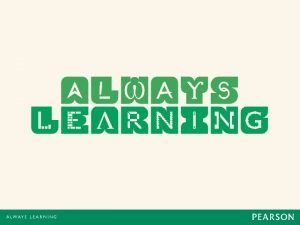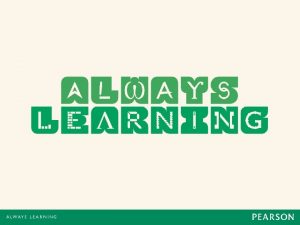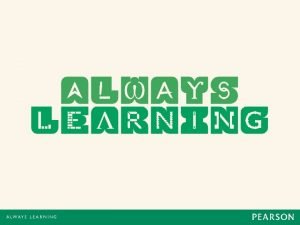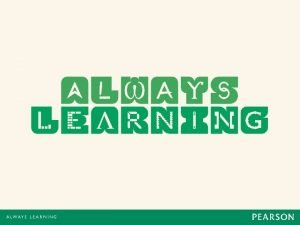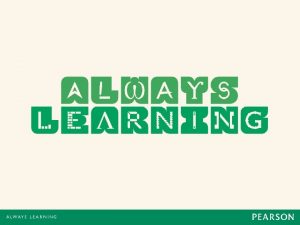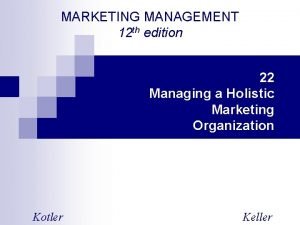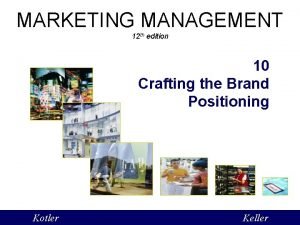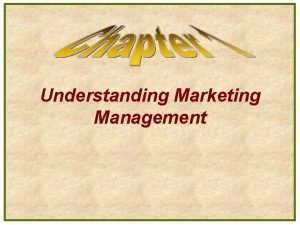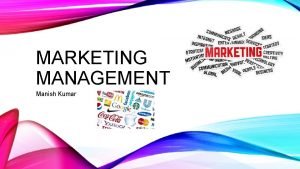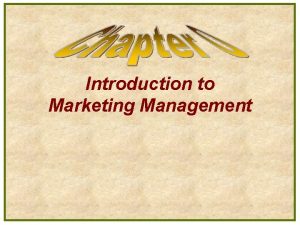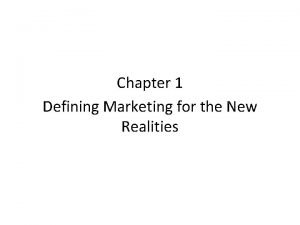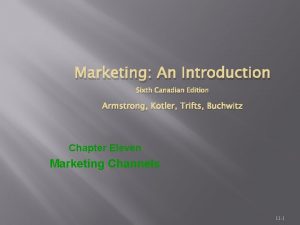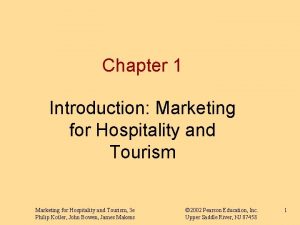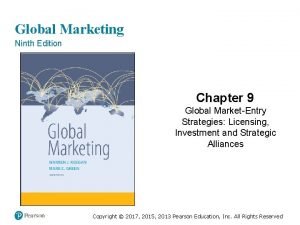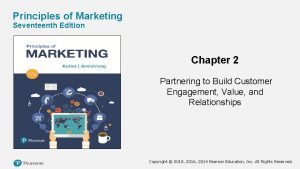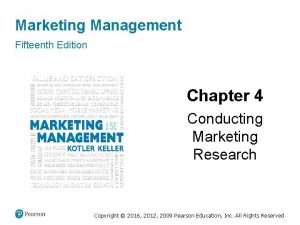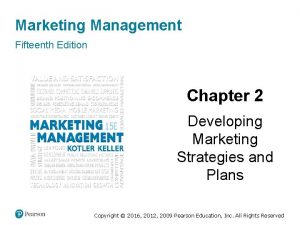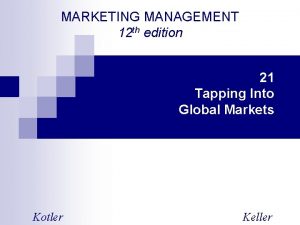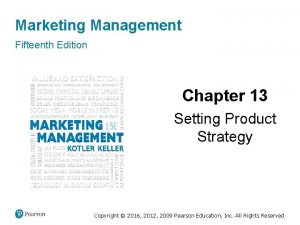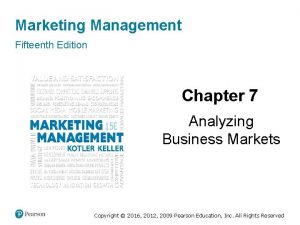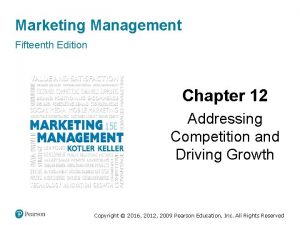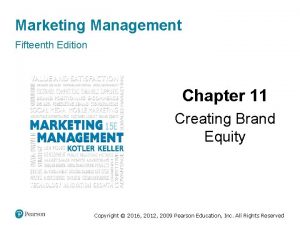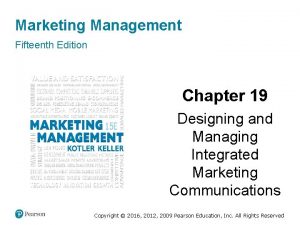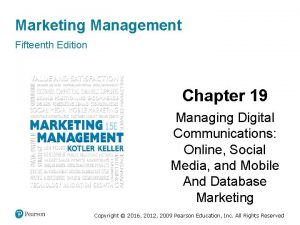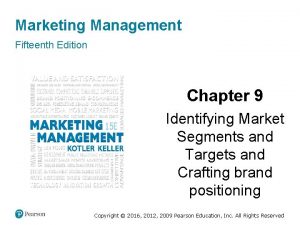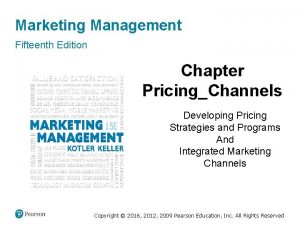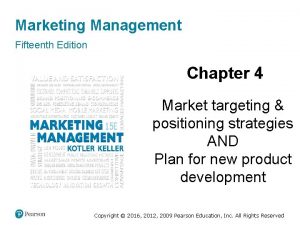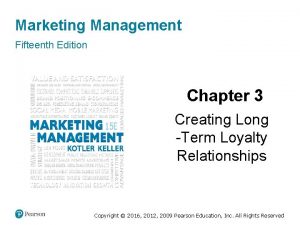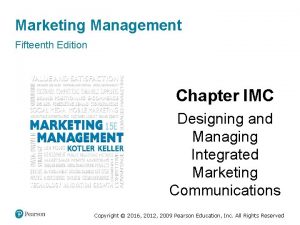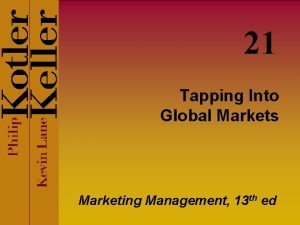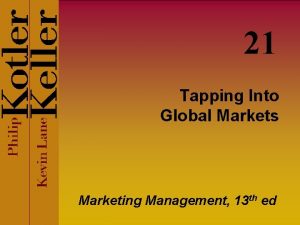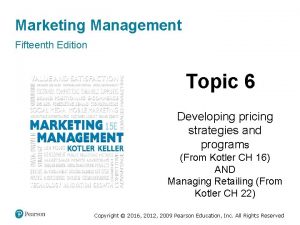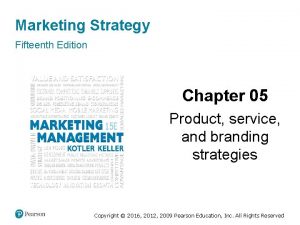Marketing Management Fifteenth Edition Chapter 8 Tapping into






































- Slides: 38

Marketing Management Fifteenth Edition Chapter 8 Tapping into Global Markets Copyright © 2016, 2012, 2009 Pearson Education, Inc. All Rights Reserved

Learning Objectives 8. 1 What factors should a company review before deciding to go abroad? 8. 2 How can companies evaluate and select specific international markets to enter? 8. 3 What are the differences between marketing in a developing and a developed market? 8. 4 What are the major ways of entering a foreign market? 8. 5 To what extent must the company adapt its products and marketing program to each foreign country? 8. 6 How do marketers influence country-of-origin effects? Copyright © 2016, 2012, 2009 Pearson Education, Inc. All Rights Reserved

Competing on a Global Basis • Global industry – Competitors’ strategic positions in major geographic or national markets are affected by their overall global positions • Global firm – Operates in more than one country and captures R&D, production, logistical, marketing, and financial advantages not available to purely domestic competitors Copyright © 2016, 2012, 2009 Pearson Education, Inc. All Rights Reserved

Figure 8. 1 Decisions In International Marketing Copyright © 2016, 2012, 2009 Pearson Education, Inc. All Rights Reserved

Deciding Whether to Go Abroad (1 of 2) • Factors that draw companies into the international arena – Some international markets present better profit opportunities than domestic market – Firm needs larger customer base to achieve economies of scale – Firm wants to reduce dependence on any one market – Firm counterattacks global competitors in home markets – Customers going abroad require international service Copyright © 2016, 2012, 2009 Pearson Education, Inc. All Rights Reserved

Deciding Whether to Go Abroad (2 of 2) • Before making a decision to go abroad, the company must also weigh several risks – Firm might not understand foreign preferences, failing to offer competitively attractive product – Firm might not understand foreign country’s culture – Firm might underestimate foreign regulations and incur unexpected costs – Firm might lack managers with international experience – Foreign country might change commercial laws, devalue currency, or expropriate foreign property Copyright © 2016, 2012, 2009 Pearson Education, Inc. All Rights Reserved

Internationalization Process Stage 1: No export activities Stage 2: Export via independent representatives Stage 3: Establishment of sales subsidiaries Stage 4: Establishment of production facilities abroad Copyright © 2016, 2012, 2009 Pearson Education, Inc. All Rights Reserved

Deciding Which Markets to Enter • How many markets to enter Waterfall Approach (gradually entering countries in sequence. e. g. , BMW, GE) Sprinkler Approach (entering many countries simultaneously. e. g. , Microsoft) Born Global (e. g. , technology intensive firms, online ventures) Copyright © 2016, 2012, 2009 Pearson Education, Inc. All Rights Reserved

Evaluating Potential Markets • Neighboring countries (understand them better and can control their cost more effectively. US to Canada and Mexico) • Psychic proximity/cultural distance (same language, , laws, and culture. ) • Fewer countries Copyright © 2016, 2012, 2009 Pearson Education, Inc. All Rights Reserved

Succeeding in Developing Markets (1 of 7) • BRICS – Brazil, Russia, India, China, and South Africa • CIVETS – Columbia, Indonesia, Vietnam, Egypt, Turkey, and South Africa Copyright © 2016, 2012, 2009 Pearson Education, Inc. All Rights Reserved

Succeeding in Developing Markets (1 of 7) • Developing world represents huge potential of many goods including, food, shelter, medical, electronics, appliances etc. • Nestle estimates 1 billion consumer from emerging countries with increasing income for their product. Currently, the company makes 40% of its revenue from these countries. • 50% of Unilever’s sales come from developing countries. Copyright © 2016, 2012, 2009 Pearson Education, Inc. All Rights Reserved

Succeeding in Developing Markets (2 of 7) • Brazil ‒ Biggest economy in Latin America ‒ Sixth largest economy in the world ‒ Fifth-largest country of digital users ‒ High cost of transporting products ‒ Crime and corruption exist Copyright © 2016, 2012, 2009 Pearson Education, Inc. All Rights Reserved

Succeeding in Developing Markets (3 of 7) • Russia ‒ Largest exporter of natural gas ‒ Second-largest exporter of oil ‒ Third-largest exporter of steel/aluminum ‒ Make heavy use of social media ‒ Dwindling workforce/poor infrastructure Copyright © 2016, 2012, 2009 Pearson Education, Inc. All Rights Reserved

Succeeding in Developing Markets (4 of 7) • India ‒ Lively democracy/youthful population ‒ World’s second most populous nation (1. 21 billion people) ‒ One of the youngest large economies (1/4 th of world’s under 25 population lives in India) ‒ Has fully embraced mobile technology ‒ Poor infrastructure/public services Copyright © 2016, 2012, 2009 Pearson Education, Inc. All Rights Reserved

Succeeding in Developing Markets (5 of 7) • China ‒ Largest auto market in the world ‒ Emerging urban middle class ‒ World’s top consumer of luxury goods ‒ Fierce competition among foreign firms ‒ Opaque and arbitrary bureaucracy Copyright © 2016, 2012, 2009 Pearson Education, Inc. All Rights Reserved

Succeeding in Developing Markets (6 of 7) • South Africa ‒ Access point to the African region ‒ Increasing discretionary income ‒ Consumers are brand conscious ‒ Increasing reliance on mobile phones ‒ Logistical/infrastructure problems Copyright © 2016, 2012, 2009 Pearson Education, Inc. All Rights Reserved

Succeeding in Developing Markets (7 of 7) • Indonesia ‒ Increasing political stability ‒ Increasing economic growth ‒ Largest Muslim country ‒ Consumers are brand conscious ‒ Distribution/infrastructure limitations Copyright © 2016, 2012, 2009 Pearson Education, Inc. All Rights Reserved

Figure 8. 2 Modes of Foreign Market Entry Copyright © 2016, 2012, 2009 Pearson Education, Inc. All Rights Reserved

Deciding How to Enter the Market (1 of 5) • Indirect exporting – Working through independent intermediaries § Domestic-based export merchants § Domestic-based export agents § Cooperative organizations § Export-management companies Copyright © 2016, 2012, 2009 Pearson Education, Inc. All Rights Reserved

Deciding How to Enter the Market (2 of 5) • Direct exporting – Handling one’s own exports § Domestic-based export department § Overseas sales branch § Traveling export sales representatives § Foreign-based distributors Copyright © 2016, 2012, 2009 Pearson Education, Inc. All Rights Reserved

Free Information About Trade and Exporting http: //www. trade. gov/ U. S. Department of Commerce’s International Trade Administration http: //www. exim. gov/ Export-Import Bank of the United States https: //www. sba. gov/ U. S. Small Business Administration Bureau of Industry and Security, https: //www. bis. doc. gov/ a branch of the Commerce Department Copyright © 2016, 2012, 2009 Pearson Education, Inc. All Rights Reserved

Deciding How to Enter the Market (3 of 5) • Licensing – Licensor issues a license to a foreign company to use a manufacturing process, trademark, patent, trade secret, or other item of value for a fee or royalty Copyright © 2016, 2012, 2009 Pearson Education, Inc. All Rights Reserved

Deciding How to Enter the Market (4 of 5) • Joint ventures – Foreign investors have often joined local investors in a joint venture company in which they share ownership and control • Direct Investment – The foreign company can buy part or full interest in a local company or build its own manufacturing or service facilities Copyright © 2016, 2012, 2009 Pearson Education, Inc. All Rights Reserved

Deciding How to Enter the Market (5 of 5) • Acquisition – Acquiring local brands for their brand portfolio Copyright © 2016, 2012, 2009 Pearson Education, Inc. All Rights Reserved

Deciding on the Marketing Program (1 of 3) Advantages Disadvantages • Economies of scale • Differences in consumer needs, wants, usage patterns • Lower marketing costs • Power and scope • Consistency in brand image • Differences in consumer response to marketing programs • Differences in brand • Ability to leverage good ideas development process • Uniformity of marketing • Differences in legal environment practices Copyright © 2016, 2012, 2009 Pearson Education, Inc. All Rights Reserved

Deciding on the Marketing Program (2 of 3) Table 8. 1 Globally Standardized Marketing Pros and Cons Advantages Economics of scale in production and distribution Lower marketing costs Power and scope Consistency in brand image Ability to leverage good ideas quickly and efficiently Uniformity of marketing practices Disadvantages Ignores differences in consumer needs, wants, and usage patterns for products Ignores differences in consumer response to marketing programs and activities Ignores differences in brand product development and the competitive environment Ignores differences in the legal environment Ignores differences in marketing institutions Ignores differences in administrative procedures Copyright © 2016, 2012, 2009 Pearson Education, Inc. All Rights Reserved

Deciding on the Marketing Program (3 of 3) • Global similarities and differences – The Internet, cable and satellite TV, and global linking of telecommunications networks have led to a convergence of lifestyles • Hofstede four cultural dimensions – – Individualism versus collectivism High versus low power distance Masculine versus feminine Weak vs. strong uncertainty avoidance Copyright © 2016, 2012, 2009 Pearson Education, Inc. All Rights Reserved

Marketing Adaptation (1 of 2) • Product features • Advertising media • Labeling • Brand name • Colors • Packaging • Materials • Advertising execution • Sales promotion • Advertising themes • Prices Copyright © 2016, 2012, 2009 Pearson Education, Inc. All Rights Reserved

Marketing Adaptation (2 of 2) Table 8. 2 Mc. Donald’s Global Menu Variations Country Noteworthy Menu Items United States Big Mac, Chicken Mc. Nuggets, Filet-o-Fish, Egg Mc. Muffin, Fries India Mc. Veggie, Chicken Maharaja-Mac, Mc. Spicy Paneer France Le Mc. Baguette, Le Croque Mc. Do, Le Royal with Cheese Egypt Beef N Pepper, Mc. Arabia (grilled kofta), Mc. Falafel Israel Mckebab, Mc. Falafel, Big New York and Big Texas (hamburgers) Japan Ebi Filet-O, Mega Teriyaki Burger, Bacon Egg and Lettuce Wrap, Shaka Chicken China Prosperity Burger, Taro Pie, Mc. Wings, Mc. Nuggets with Chili Garlic sauce Brazil Banana Pie, Mc. Nifico Bacon, Cheddar Mc. Melt, Big Tasty Mexico Big Mac, Mc. Chicken, Fries, etc. Copyright © 2016, 2012, 2009 Pearson Education, Inc. All Rights Reserved

Global Product Strategies (1 of 4) • Product standardization (Google, e. Bay, Facebook) Copyright © 2016, 2012, 2009 Pearson Education, Inc. All Rights Reserved

Figure 8. 3 Product & Communication Strategies (Warren Keegan) Copyright © 2016, 2012, 2009 Pearson Education, Inc. All Rights Reserved

Global Product Strategies (2 of 4) • Straight extension: camera, electronics) • Product adaptation: regional version, country version, city version, retailer version) Copyright © 2016, 2012, 2009 Pearson Education, Inc. All Rights Reserved

Global Product Strategies (2 of 4) • Product invention – Backward invention: reintroduces earlier product forms well adapted to a foreign country’s needs – Forward invention: creates a new product to meet a need in another country Copyright © 2016, 2012, 2009 Pearson Education, Inc. All Rights Reserved

Global Price Strategies (3 of 4) • Companies have three choices for setting prices in different countries – Uniform price everywhere – Market-based price – Cost-based price Copyright © 2016, 2012, 2009 Pearson Education, Inc. All Rights Reserved

Global Product Strategies (4 of 4) • Transfer price • Dumping • Arm’s-length price • Gray markets • Counterfeit products Copyright © 2016, 2012, 2009 Pearson Education, Inc. All Rights Reserved

Global Distribution Strategies • Channel entry – Figure 8. 4: Whole-Channel Concept for International Marketing • Channel differences – Various distribution systems – Size and character of retail units Fig. 8. 4 Whole-Channel Concept for International Marketing Copyright © 2016, 2012, 2009 Pearson Education, Inc. All Rights Reserved

Country-of-Origin Effects • Mental associations and beliefs triggered by a country Copyright © 2016, 2012, 2009 Pearson Education, Inc. All Rights Reserved

Copyright © 2016, 2012, 2009 Pearson Education, Inc. All Rights Reserved
 Management fifteenth edition
Management fifteenth edition Human resource management 15th edition
Human resource management 15th edition University physics with modern physics fifteenth edition
University physics with modern physics fifteenth edition Tapping into global markets
Tapping into global markets Tapping into global markets
Tapping into global markets Chapter 12 the worlds of the fifteenth century
Chapter 12 the worlds of the fifteenth century The worlds of the fifteenth century
The worlds of the fifteenth century Classical menu sequence
Classical menu sequence Fifteenth amendment
Fifteenth amendment Percussion tapping
Percussion tapping Pleural tapping notes
Pleural tapping notes How afm works
How afm works Tapping tube smelter
Tapping tube smelter Stan meyer murdered
Stan meyer murdered Empower tapping
Empower tapping Tapping sounds
Tapping sounds Cutting tool used in bench grinding machine is known as mcq
Cutting tool used in bench grinding machine is known as mcq Marketing management (arab world edition)
Marketing management (arab world edition) What is the value delivery process
What is the value delivery process Marketing management (arab world edition) philip kotler
Marketing management (arab world edition) philip kotler Keys to effective internal marketing
Keys to effective internal marketing Kotler e keller
Kotler e keller Marketing management (arab world edition) philip kotler
Marketing management (arab world edition) philip kotler Marketing management 12th edition
Marketing management 12th edition Marketing management 12th edition
Marketing management 12th edition Using mis (10th edition) 10th edition
Using mis (10th edition) 10th edition Using mis 10th edition
Using mis 10th edition Contemporary approach
Contemporary approach Marketing management definition
Marketing management definition Marketing management objectives
Marketing management objectives Defination of marketing management
Defination of marketing management The new marketing realities
The new marketing realities Marketing for hospitality and tourism 7th edition
Marketing for hospitality and tourism 7th edition Marketing an introduction 6th canadian edition
Marketing an introduction 6th canadian edition Marketing for hospitality and tourism chapter 1
Marketing for hospitality and tourism chapter 1 Global marketing 9th edition
Global marketing 9th edition Principles of marketing fifth european edition
Principles of marketing fifth european edition Slidetodoc.com
Slidetodoc.com Chapter 2 principles of marketing
Chapter 2 principles of marketing




